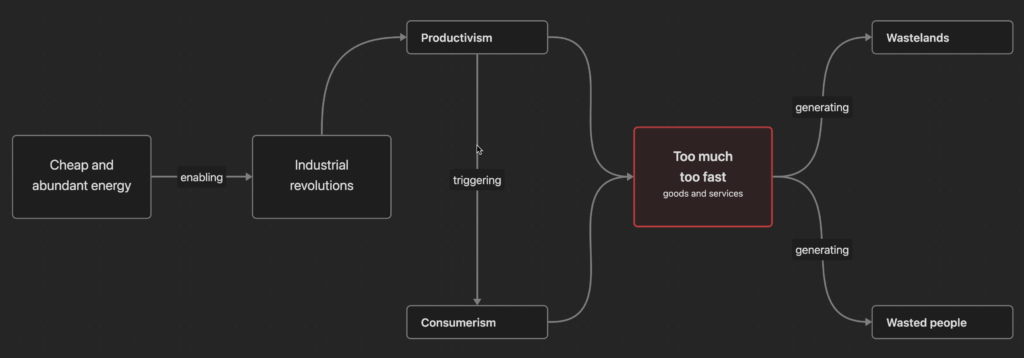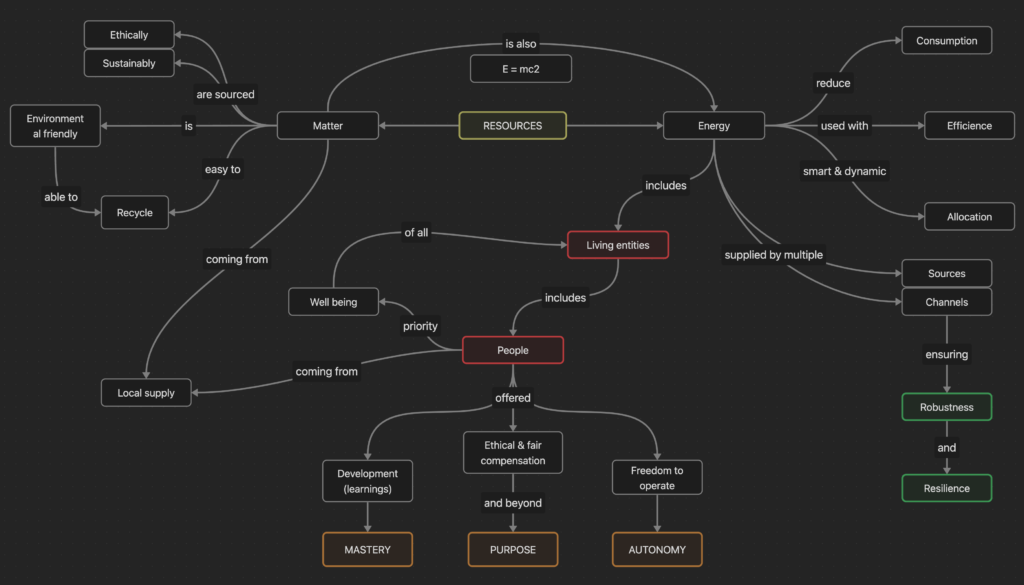Less but Better
Drawing inspiration from the slow food movement, slow business promotes a transition from a frenetic pace focused on short-term returns to a mindful emphasis on long-term value-driven outcomes.
Today’s fast-paced economy, fuelled by the burning of cheap and abundant fossil hydrocarbons, leads to overproduction of goods and services, burnouts of individuals, ecosystems, and natural resources, and a global pollution of the environment. This model has reached its limits.

The principle of “less but better” (or quality rather than quantity) advocates for focusing on the essential needs of human beings, addressing fundamental problems in a durable and resilient manner. This implies these solutions have a limited impact on ecosystems as keeping later viable and enjoyable is a key part of humans’ “essential needs”.
Essential and Non-Essential
Business value can encompass tangible (increased revenue or cost savings) and intangible benefits (improved customer satisfaction or brand reputation).
Business value is context-specific. To differentiate between essential and non-essential investments, companies need to employ a systematic approach.
- conduct a thorough value stream mapping to identify all activities and their interconnections (this is where knowledge graphs can help)
- implement a rigorous cost-benefit analysis for each element, quantifying its contribution to key performance indicators
- utilize techniques like the 80/20 rule (Pareto principle) or lean management principles to prioritize value-adding activitie
Linking all these elements is tricky; this is where knowledge graphs can help.
Performances Measurement
High-performing systems are optimized for maximum efficiency. This optimization/configuration is based on given contextual parameters (conditions). In a different context, the configuration of the system would have been different.
Optimization makes high-performing systems fragile as they lose efficiency and often struggle to adapt when unexpected changes or disruptions happen in their environment.
In contrast, lower-performing systems that prioritize resilience and sustainability may be less efficient in the short term but better equipped to withstand challenges and adapt over time. Slow business embraces this trade-off, recognizing that a more measured approach can lead to greater long-term success and stability.
Resources
Slow business requires a holistic and sustainable resource (material, energy and people) management approach.

Mastery, purpose and autonomy is what truely motives people and keep them engaged as explained by Dan Pink.
Environmentally consciousness
The human brain is designed to respond to immediate environmental stimuli, relying on biological sensors for processing information crucial for survival. It prioritizes nearby sensory input, often filtering out distant or abstract concepts that lack direct relevance to the present.
In theoretical situations, the brain struggles to engage without tangible sensory input; some people manage to do it via thought experiments. This limitation hinders our environmental consciousness beyond immediate surroundings.
This emphasis on the present may result in a limited ability to anticipate future challenges that aren’t based on our current experiences. Effectively using technology in a sustainable way to gather and access knowledge beyond our immediate environment is crucial for developing a broader awareness of the various systems we are part of.
Long-term thinking
Two birds in the bush are worth one in the hand.
The saying “A bird in the hand is worth two in the bush” leads to a scenario where we end up with no birds at all. We must shift our mindset from focusing on short-term, minimal gains to prioritizing long-term sustainable value creation.
Businesses committed to long-term thinking get several advantages
- more robust and resilient operations
- innovation and adaptability
- a stronger and more respectable brand
- better decision-making
- talent attraction and retention
In a VUCA* environment, having a plan (mid- to long-term) empowers businesses to proactively adapt and thrive, rather than being caught off guard and suffering the consequences of complacency.
* Volatile, Uncertain, Complex and Ambiguous
